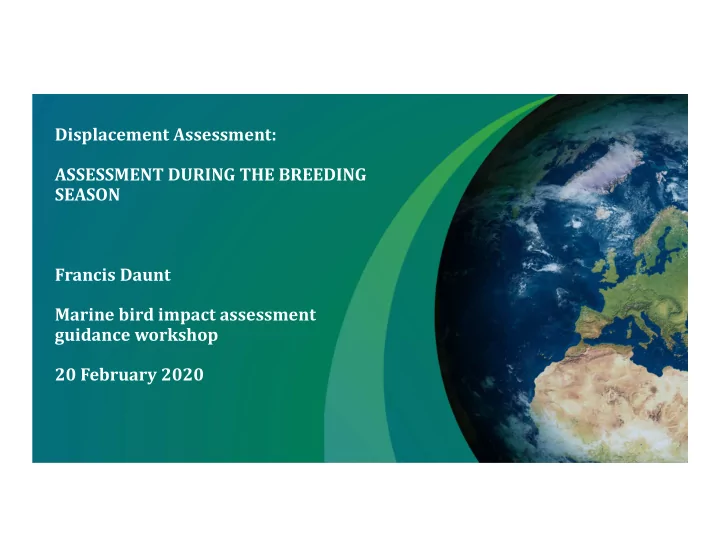

Displacement Assessment: ASSESSMENT DURING THE BREEDING SEASON Francis Daunt Marine bird impact assessment guidance workshop 20 February 2020
Acknowledgements • Kate Searle (CEH), Adam Butler (BioSS) and Deena Mobbs (CEH) • Funded projects from Marine Scotland • Project Steering Group members: MS, SNH, JNCC, NE, RSPB
Displacement in the breeding season • Breeding seabirds may be displaced from favoured foraging habitats by Offshore Renewable Developments • Potential for negative consequences on SPA populations
Displacement Matrix Joint Statutory Nature Conservation Bodies (SNCB) Interim Displacement Advice Note (2017)
Displacement Matrix calculation Density in footprint x Displacement rate x SeabORD Mortality rate
Sub-lethal effects Sub-lethal Driver Behaviour Energetics Population size Demographic rates
SeabORD Individual-based model Simulate foraging behaviour of individuals in accordance with seabird behaviour and • optimal foraging theory (maximising energy intake / minimising time spent foraging) Displacement: individuals relocate and experience patch depletion and competition • effects whilst foraging in a location Barrier effects: Individuals incur additional flight costs • Fate of individual birds experiencing displacement and barrier effects: • - Effects on adult survival (via changes in body mass) - Effects on productivity
SeabORD Inputs Bird utilisation distribution • Prey distribution • Displacement and barrier rate • Footprint shapefiles • ‘border’ width (km) to be added for OWF footprints • ‘buffer’ width (km) to be added to OWF footprints • Species-specific parameters: • - Adult and chick body mass - Adult DEE and chick energy requirement - Adult and chick critical body mass - Activity costs - Length of season - Intake rates
SeabORD flight lines
SeabORD Worked Example
SeabORD Worked Example
SeabORD Worked Example Generates adult and chick masses and • number of foraging flights per day Generates time budgets (time spent • foraging and flying)
SeabORD Worked Example
SeabORD Limitations Chick-rearing period only • Simple flight lines • Only currently parameterised for 4 species: kittiwake, guillemot, razorbill, puffin • • Processing time to run can be long Requires initial calibration to set baseline conditions appropriately in line with • empirical observations of adult mass loss and productivity
How to use SeabORD in assessments • Where you have a defensible Utilisation Distribution of breeding birds: • Run SeabORD • Where this is absent: • Run SeabORD emulator to estimate mortality rate • Run SeabORD using a 'generic' bird UD (e.g. derived from models of seabird distribution) to estimate mortality rate • Use mortality rate in displacement calculation: density x displacement rate x mortality rate
SeabORD emulator • Explanatory variable: mortality rate per individual in footprint • Covariates (available everywhere) - Footprint distance to colony - Footprint alignment to colony - Density in footprint - Survival - Productivity • Run SeabORD across the full range of each input to derive regression equation • Use regression equation based on known covariates
How to use SeabORD in assessments Mean abundance of birds in footprint From local at-sea From UD and colony surveys count SeabORD with UD derived from good local GPS with UD derived from multi-site modelling of GPS data (e.g. Wakefield et al., 2017) with UD derived from MERP at-sea survey maps & SNH apportioning SeabORD Emulator n/a
SeabORD: integration of Collision Sub-lethal Driver Behaviour Energetics Population size Demographic rates
Contribution of SeabORD to summer assessments Current approaches use expert judgement to estimate • mortality rate of displaced birds Density in footprint SeabORD estimates mortality of displacement based • x on biological realism Displacement rate SeabORD is flexible in how it can be used, dependent • on the availability of input data x Key pointers on data gaps • Mortality rate New version of SeabORD (available March) will • integrate collision and displacement effects
Recommend
More recommend